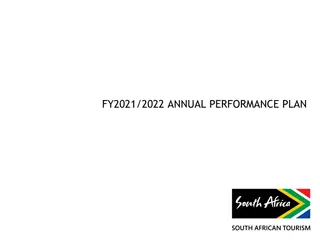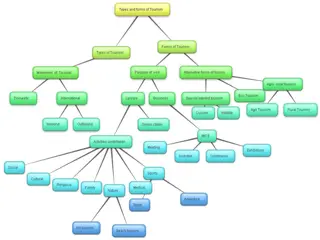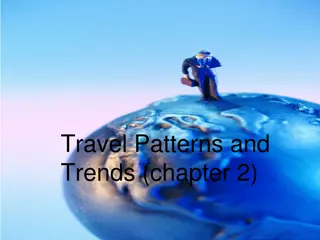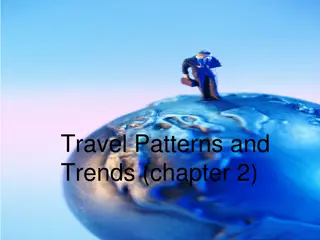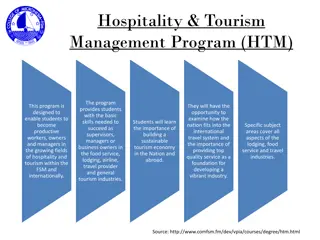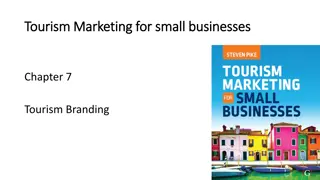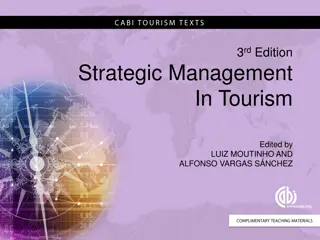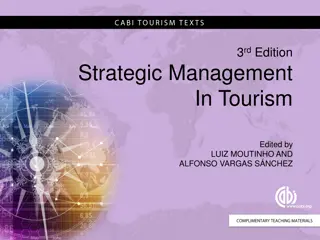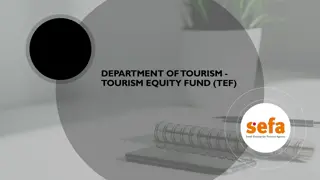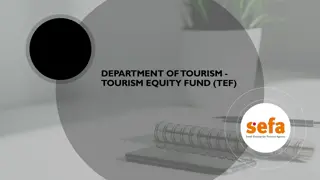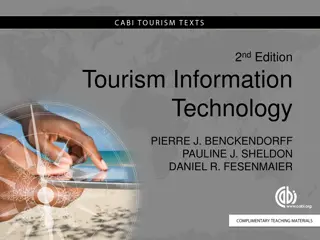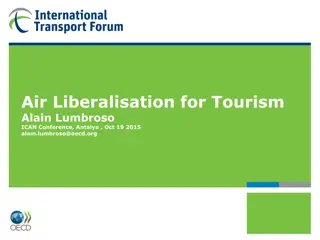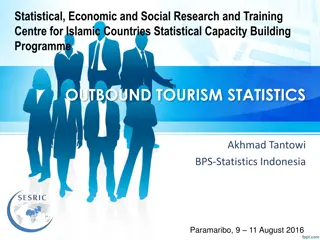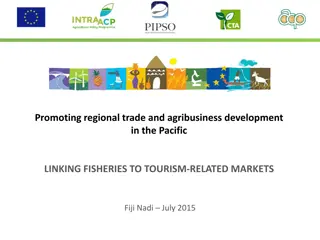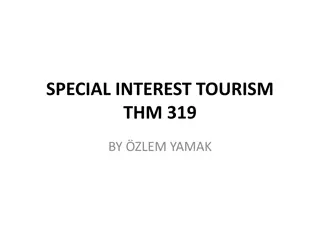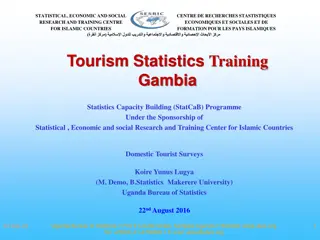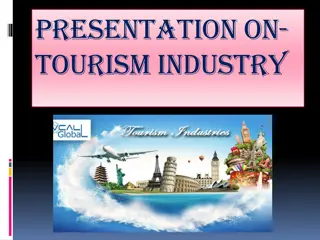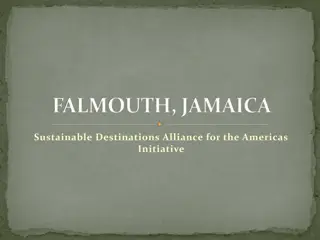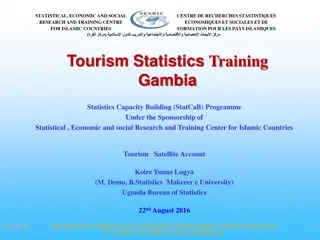Evolution of Internet Technology in Tourism: A Comprehensive Study
Exploring the impact of the Internet on tourism, this study delves into topics such as historical evolution, Internet usage by travelers and organizations, search engine optimization, and web development for successful tourism sites. Key concepts like ISPs, servers, domains, and eCommerce are discussed, along with the evolution of the Internet from ARPANet to present-day social media and e-commerce giants. The growth of Internet users worldwide is analyzed, along with the configuration of Internet, intranet, and extranet systems. Standards like WWW, domains, protocols, and programming languages are also detailed in this informative guide.
Download Presentation

Please find below an Image/Link to download the presentation.
The content on the website is provided AS IS for your information and personal use only. It may not be sold, licensed, or shared on other websites without obtaining consent from the author. Download presentation by click this link. If you encounter any issues during the download, it is possible that the publisher has removed the file from their server.
E N D
Presentation Transcript
3rdEdition Tourism Information Technology PIERRE J. BENCKENDORFF ZHENG XIANG PAULINE J. SHELDON
Chapter 4 The Internet and the Tourist
Chapter 4 Learning Objectives After studying this chapter you should be able to: 1. Understand the historical evolution and key terms related to the Internet; 2. Explain how the Internet can be used by travelers and travel organizations and categorize different types of travel sites found on the Internet; 3. Explain the online information search process and analyze the factors that influence search rankings and online search behavior; and 4. Apply an understanding of communications, marketing and user experience design to the development of successful tourism websites.
Key Concepts Internet Service Provider (ISP) Servers and firewalls Intranet, extranet, Internet World Wide Web (WWW) Web 2.0 Domains, protocols, languages, formats eCommerce Search Engine Reply Page (SERP) Search Engine Optimization (SEO) and Metatags Intelligent Agents and Recommender Systems 4
Evolution of the Internet Six Degrees (SNS), Google Search WWW Ethernet YouTube Baidu WeChat ARPANet SITA Web Crawlers First Domain Name Oculus Rift LinkedIn Weibo 1969 1980 1990 2000 2010 Pinterest Email Internet Mosaic Browser Twitter First ISP Paypal Google Glass Airbnb Hotmail, Broadband Facebook, Skype
100% Developed Countries Developing Countries All Countries 80% Percentage 60% 40% 20% 0% 1997 2002 2007 2012 2017 Year FIGURE 4.1 Percentages of Internet Users in the World 6 Source: International Telecommunication Union (2018)
EXTRANET Public Suppliers Partners VPN/ Firewall Remote Users (VPN Client) INTERNET VPN/ Firewall INTRANET Databases Server Printer | Fax Scanner Wireless Devices Workstations FIGURE 4.2 Internet, intranet and extranet configuration 7
WWW Standards Domains Uniform Resource Locator (URL) Top-level domains (e.g. .com, .gov) Country domains (e.g. .uk, .cn) Protocols a set of rules governing the format of data sent over the Internet or other network Programming Languages e.g. HTML, XML, Java, etc. 8
Top Level Domain Names Domain .edu .com .org .net .gov .mil .travel .au Description Educational institutions Commercial institutions Organizations Networked organizations Governmental Organizations Military organizations Travel organizations Country domains, in this case Australia 9
Protocols Protocol Description TCP/IP SMTP FTP HTTP HTTPS Transmission Control Protocol/Internet Protocol Simple Mail Transfer Protocol File Transfer Protocol Hypertext Transfer Protocol Hypertext Transfer Protocol Secure 10
Common Languages and Formats Format Description Hypertext markup language XML Extensible Markup Language SMIL Synchronized Multimedia Integration Language Java Environment for running online applications MP3 Music and audio format Flash Interactive media format developed by Adobe HTML 11
Functionality of Travel Websites Global information dissemination Integration Mass Customization Interactive communication Transactional support Disintermediation 12
Types of E-Commerce in Tourism Term B2C Description Business to consumer Example A traveler purchases a flight on Lufthansa s website A tour operator purchases a block of rooms from a hotel using the Internet A tourist offers their services as an attorney to a hotel where they are staying A tourist sells souvenirs to another tourist on eBay Business to business B2B Consumer to business C2B Consumer to consumer C2C Government to consumer A tourist applies for a passport online Government to business A museum applies for a building permit to a government agency online Government to government service agreement using the Internet G2C G2B G2G Two governments negotiate a bilateral air 13
A Typology of Travel Websites Category Travel Intermediaries Travel Suppliers Social Media Online Travel Portals Online Travel Guides Trip Planning Destinations Examples expedia.com, kayak.com ihg.com, singaporeair.com tripadvisor.com, travelpod.com, wikitravel.org virtualtourist.com lonelyplanet.com, frommers.com desti.com, mygola.com australia.com, tourism.australia.com, visit-queensland.com, visitbrisbane.com.au tourism.gov.in, smartraveller.gov.au, usa.embassy.gov.au tim.hawaii.edu unwto.org, tourismconcern.org.uk, ecotourism.org Government Education Non-government organizations (NGOs) 14
PAID LISTING KNOWLEDGE GRAPH ORGANIC LISTING FIGURE 4.3 Google SERP for New York 15
Determinants of SERP Rankings 1. Whether or not the keywords are in the URL of that page 2. The frequency and size of the keywords on a webpage 3. The keywords in the link anchor text (those pieces of text which contain a link) 4. Alternative text for images 5. Metatags, keywordsin titles and descriptions embedded on a webpage 16
GOOGLE MAPS PAID LISTINGS HOTELFINDER GOOGLE MAPS PAID LISTINGS ORGANIC LISTINGS 17 FIGURE 4.4 Google SERP for New York Hotels
Pre-search Conditions Search Process Overall Evaluation Information search activities Usefulness of Internet tools Use of search engine for travel planning First planning task Task specificity Search queries SERPs evaluation Overall satisfaction Ease of use Plan quality Trust FIGURE 4.5 General Framework of Search Engine Use for Travel Planning 18 Source: Fesenmaier, Xiang, Pan, and Law (2011).
Elements of Successful Tourism Websites Planning Strategies and Goals Integrated Marketing Communications Evaluation Usability Utility Design Navigation & Interaction Aesthetics & Functionality Cross-platform compatibility Management Maintenance Resourcing Generate Traffic & Repeat Visitors Delivery Readability, credibility, accuracy Personalization Marketing Mix 19
Marketing Mix and Travel Websites Product Partnerships Price Website Elements Packaging Promotion Programming Point-of-sale People 20
Discussion Questions 1. Identify a travel enterprise that uses an Intranet. What features does it provide? Can you suggest other ways that the enterprise could use the Intranet? 2. Find one specific example each of a G2G, G2B and G2C networks in the tourism industry. Explain in detail. 3. In this chapter we present a typology of travel websites. Conduct a search to find your own examples of sites for each category. Were there any sites that do not fit into this typology? 4. Identify two search engines (e.g. Bing and Google)and compare and contrast how they deal with travel requests. Do this by choosing a specific trip you would like to go on. 5. We have presented a number of elements that make tourism websites successful. Visit the travel website for your local region and conduct your own assessment of the quality of this website based on the elements we have presented. Prepare a set of recommendations to improve this website. 21
Useful Websites The Search Engine List www.thesearchenginelist.com The Internet Society www.internetsociety.org Search Engine Land searchengineland.com ICANN www.icann.org E-Tourism Frontiers www.e-tourismfrontiers.com WWW Consortium (W3C) www.w3.org Nielsen Norman Group www.nngroup.com/articles Google www.google.com 22
Case Study: Roadtrippers Founded 2011, Roadtrippers allows users to: discover and add independently owned points of interest to a travel itinerary rate, review, and read what other users have to say about points of interest Hotel metasearch was added in 2015 to display prices from multiple hotel booking providers on specific accommodations A vertical search engine which focuses on a specific type of tourism product. Supports information search, trip planning and group decision making by connecting independent travellers with small tourism businesses 23





